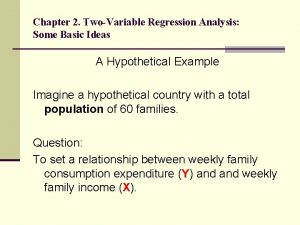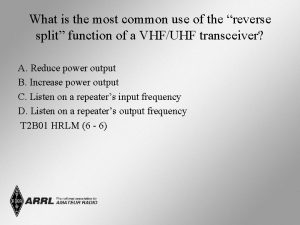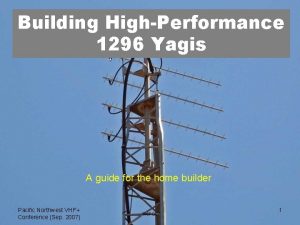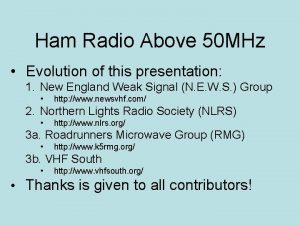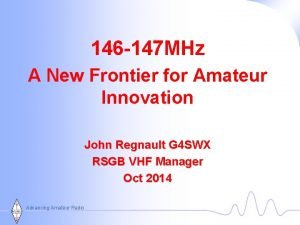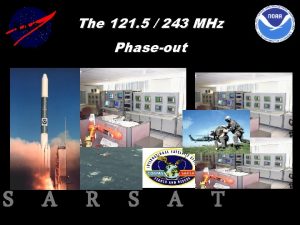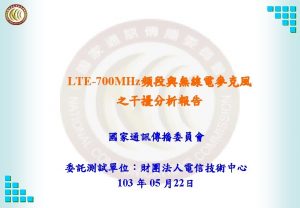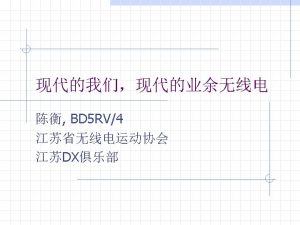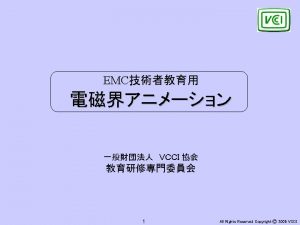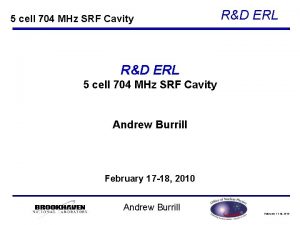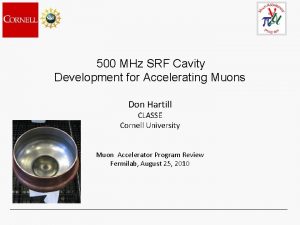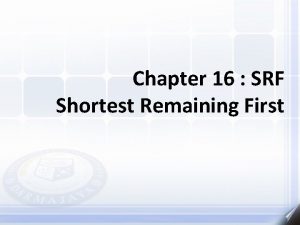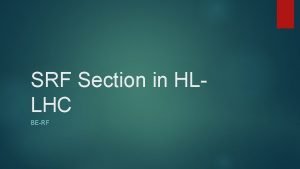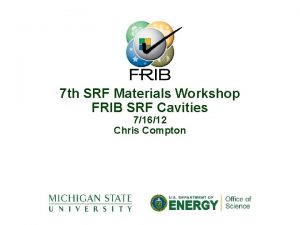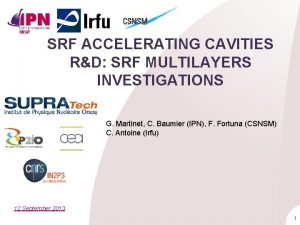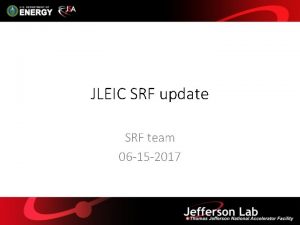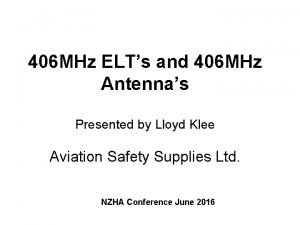The first 802 MHz SRF Cavity and the














- Slides: 14

The first 802 MHz SRF Cavity ‘and the next four? ’ 3 rd PERLE Collaboration Meeting 15 -16 th January 2018 Daresbury, UK Frank Marhauser Robert Rimmer Wednesday, October 7, 2020

Overview • Jefferson Lab has a collaboration with CERN to build: - One single-cell fine-grain niobium 802 MHz cavity (completed) - One 5 -cell fine-grain 802 MHz cavity (completed) - Two single-cell OFHC 802 MHz cavities (advanced) • Both Nb cavities were completed and tested at 2 K in 2017 • The OFHC cavities are deemed for R&D purposes such as Nbsputtering and will be shipped to CERN - Fabrication is advanced, 1 additional cavity from clamped half cells and beam tubes with up to 2 cells will be made for bench measurements • In addition, Jefferson Lab has looked into: - Higher Order Mode (HOM) coupler design - This design work is preliminary • Additional Funding will be required to make more progress 2 3 rd PERLE Collaboration Meeting, Daresbury 15 -16 January 2018

Cavity Design • A new 802 MHz 5 -cell ERL cavity design has been proposed by JLab as a candidate for LHe. C in mid 2015 - Cavity performance parameters were optimized to balance Epk/Eacc, Bpk/Eacc, R/Q∙G at a given beam tube diameter - Straight beam tubes with an ID = 130 mm have been chosen eventually for prototyping - Takes into account ability to damp all crucial HOMs efficiently with beam tube couplers - The prototype can be made from a single-die design, i. e. mid cells and end cells have the same cell contour saves prototyping costs - This is not required for cavity series fabrication, and end cells may be tweaked if at all necessary to improve HOM damping tube ID=115 mm tube ID=140 mm 3 3 rd PERLE Collaboration Meeting, Daresbury 15 -16 January 2018 tube ID=130 mm

Parameter Table for LHe. C Cavity Candidates Parameter Cavity type Frequency Number of cells Lactive Long. loss factor (2 mm rms bunch length) R/Q = Veff 2/(ω*W) R/Q/cell G R/Q∙G/cell Eq. Diameter Iris Diameter Tube Diameter Eq. /Iris ratio Wall angle (mid-cell) Epk/Eacc (mid-cell) Bpk/Eacc (mid-cell) kcc N 2/kcc cutoff TE 11 cutoff TM 01 Unit Value JLab Value CERN Ver. 1 from CERN-ACC-NOTE-2015 R Calaga, 5/28/15 801. 58 5 935 Value CERN Ver. 2 from CERN-ACC-NOTE-2015 R. Calaga, 5/28/15 MHz mm 917. 9 V/p. C 2. 742 2. 894 2. 626 Ω Ω Ω mm mm mm degree m. T/(MV/m) % GHz 523. 9 104. 7 274. 6 28788 328. 0 130 2. 52 0 2. 26 4. 20 3. 21 7. 78 1. 35 1. 77 430 86. 0 276 23736 350. 2 150 2. 19 12. 5 2. 26 4. 77 4. 47 5. 59 1. 17 1. 53 393 78. 6 283 22244 350. 2 160 2. 19 12. 5 2. 40 4. 92 5. 75 4. 35 1. 10 1. 43 4 3 rd PERLE Collaboration Meeting, Daresbury 15 -16 January 2018 935

Cavity Fabrication • We developed all tooling for cavity fabrication Fixture for female die with blank holder Male die Beam tube rolling die Five-cell cavity in EBW machine prepared for subsequent dumbbell and endgroup welding with both outside and inside welds in tilted position RF half cell/dumbbell measurements fixture Five-cell cavity on tuning bench 5 3 rd PERLE Collaboration Meeting, Daresbury 15 -16 January 2018

Post-Processing - Electropolishing (EP) • New flange adapters were required to enable electropolishing with existing machine -Cavity just fits into system (largest cavity so far eletropolished at JLab) • Electropolishing carried out successfully with outside temperature control (water spraying, cavity walls < 25 deg. C) 6 3 rd PERLE Collaboration Meeting, Daresbury 15 -16 January 2018

Status of Deliverables 802 MHz Nb single-cell and five-cell cavity completed Cavity Qty. Material Half cells deepdrawn Beam Tubes deep-drawn/ rolled 1 -cell 1 FG Nb 2/2 5 -cell 1 FG Nb 10/10 1 -cell 2 OFHC CERN Material 8/4 up to 2 cells clamped 1 OFHC JLab material 4/4 Flanges machined Clamped OFHC copper end-group and dumbbell prior to final trimming Endgroup EBW (end cell + tube + flange) Dumbbells EBW Machining/ Trimming Cavity EBW 2/2 Nb. Ti flanges 2/2 n/a YES 2/2 Nb. Ti flanges 2/2 4/4 YES 8/4 More than needed 4/4 SS 316 LN after final tube machining (in progress) n/a 4/2 More than needed 2/2 SS 316 LN after final tube machining (in progress) n/a 7 3 rd PERLE Collaboration Meeting, Daresbury 15 -16 January 2018 In progress after endgroup production Not needed

Post-Processing • Both Nb cavities went through similar post-processing steps Step Single-Cell cavity Five-Cell cavity Frequency measurement (air, warm) as built YES Optical weld inspection YES (before final tube weld) YES Field flatness check NO – not required YES (FF = 85. 3% as built) Bench Tuning NO – not required YES (FF = 98 %) US thickness measurements YES, during BCP YES Degreasing YES Bulk BCP YES - 160 um at equators YES - 200 um at equators Frequency measurement after bulk chemistry YES Field flatness check NO – not required YES (FF = 96. 4%) Optical weld inspection YES No High temperature heat treatment YES, 800 deg. C/3 hrs. Calibrate RF antennas YES Lapping of flanges YES US degreasing YES Final EP YES (30 um EP by integrated current) US thickness measurements after EP YES High Pressure Rinse with DI water YES (2 cycles) YES (4 cycles) Assembly/evacuation in test stand YES Leak check YES Low-T bake 8 12 hours) YES (120 deg. C for 3 rd PERLE Collaboration Meeting, Daresbury 15 -16 January 2018 Frank Marhauser YES (120 deg. C for 12 hours)

Single-cell Cavity Vertical Test Results at 2 Kelvin • After post-processing the 1 st vertical test suffered from an early field emission onset and test was aborted (also superfluid leak was observed) • We re-rinsed the cavity and performed 2 nd vertical test, which unfortunately suffered from a cable shortage and apparent superfluid leak • We repaired the cable and re-torqued the flanges ( no superfluid leak anymore), but did not re-rinse the cavity Test 3 FE onset MP barrier (+ radiation) ~30 minutes to process Quench Performance limit: - Quench at Eacc, max = 32. 3 MV/m (Bpk ~ 135 m. T) and Q 0=1. 7 e 10 9 3 rd PERLE Collaboration Meeting, Daresbury 15 -16 January 2018

Five-cell Cavity Vertical Test Results at 2 Kelvin • • No superfluid leak and cable problems encountered No multipacting barrier and associated radiation detected Field emission however was present with onset at ~17 MV/m Plan is to re-rinse and test again to see whether field emission can be mitigated Test 1 FE onset Quench Performance limit: - Quench at Eacc, max = 31 MV/m (Bpk ~ 130 m. T) and Q 0 = 2 e 10 10 3 rd PERLE Collaboration Meeting, Daresbury 15 -16 January 2018

Preliminary HOM Studies • Preliminary HOM studies were carried out incorporating LHC-type HOM couplers (and FPC) scaled to adapt to new cavity shape at 802 MHz - Broadband damping efficiency was found to be not optimal since also narrowband loop couplers are employed as required for LHC cavities • We considered using new coaxial HOM-couplers or scaled versions of existing designs (TESLA/JLab-type couplers) with up to 3 couplers combined in a single ‘Y’ endgroup - Benefit of ‘Y’ endgroup: Minimizes/eliminates dependency on transverse mode polarization • Alternative: Broadband waveguide HOM couplers, e. g. as developed at JLab in the past for Ampere-class ERLs - - - Waveguide rather ‘overkill’ for PERLE since 3 -pass peak beam current is comparably small (< 100 m. A) Benefit: Waveguides do not require tuning of notch filter and are broadband by nature Yet, trapped TE 111 and TM 110 dipole modes with high impedances might be better captured with coaxial couplers (cf. Supercond. Sci. Technol. 30 (2017) 063002) scaled LHC cavity coax FPC coupler scaled LHC cavity loop coupler (narrowband) scaled LHC cavity antenna coupler(broadband) HOM ‘Y’ endgroup with 3 coaxial couplers (here with scaled TESLA-type couplers) 11 3 rd PERLE Collaboration Meeting, Daresbury 15 -16 January 2018 HOM ‘Y’ ‘High Current’ waveguide coupler endgroup

PERLE HOM Beam Spectrum • We performed an HOM wakefield analysis using the PERLE recombination pattern to evaluate the real power dissipated in the HOM loads (from monopole HOM spectrum) - Spectrum up to 6 GHz far beyond 1 st beam tube cutoff assessed including all high impedance modes - Good news is that wakefield spectrum reveals no crucial HOMs close to beam spectral lines - At 25 m. A injected current (75 m. A peak current in ERL) we obtain a reasonably low HOM power of ~30 Watts (here shared by 3 coaxial HOM couplers and beam tubes) Bunch recombination pattern for PERLE (cf. CDR). Bunches at different energies (the turn number is indicated) are separated by nearly constant bunch spacing. 12 3 rd PERLE Collaboration Meeting, Daresbury 15 -16 January 2018

Summary and Prospects • JLab has completed the design, fabrication, post-processing and successful vertical testing of new 802 MHz Niobium prototype cavities in collaboration with CERN (OFHC cavities follow, to be delivered to CERN) • 5 -cell cavity is baseline design for the PERLE main linac -I. e. design for CERN LHe. C/FCC cavity is identical to PERLE cavity • JLab has all the tools to build further cavities for PERLE -JLab has provided a quote for cavity costs to project (‘the next four’) -Funding and decision by PERLE management is required to move ahead • Major task ahead for PERLE is development of suitable HOM couplers and FPC coupler -This task is steered by Orsay -Takes into account compatibility with cryomodule -Jlab is proceeding with similar effort for JLEIC cooler ERL • Future R&D could proceed using available 1 -cell and 5 -cell cavities, i. e. replace beam tubes with coupler endgroups to study HOM damping efficiency with respect to damping requirements for PERLE -Further funding would be required 13 3 rd PERLE Collaboration Meeting, Daresbury 15 -16 January 2018

Questions ?
 Dorsal cavity diagram
Dorsal cavity diagram Bridges from 802.x to 802.y
Bridges from 802.x to 802.y Bridges from 802.x to 802.y
Bridges from 802.x to 802.y Body cavities
Body cavities Abdominopelvic cavity location
Abdominopelvic cavity location Omental bursa
Omental bursa Lesser sac anatomy
Lesser sac anatomy Sample regression function
Sample regression function Where may ssb phone be used in amateur bands above 50 mhz?
Where may ssb phone be used in amateur bands above 50 mhz? 25 mhz band
25 mhz band G3jvl loop yagi
G3jvl loop yagi Meteor scatter 144 mhz
Meteor scatter 144 mhz 147 mhz
147 mhz 121,5 mhz
121,5 mhz A benchmark program is run on a 40 mhz processor
A benchmark program is run on a 40 mhz processor







